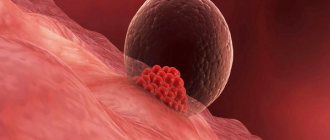What is considered normal?
In most cases, bleeding at the time of egg release is not considered a pathology. This phenomenon is very common, so women no longer pay any attention to it until they begin to monitor the work of their body in order to plan a pregnancy. The blood itself in the middle of the MC indicates hormonal changes.
Some studies on fertility say that this kind of secretion on day 14 of a 28-day cycle is a positive factor, since it confirms the rupture of the follicle. In this regard, ladies know when it is necessary to plan for a baby. When blood appears for the first time, there is no need to immediately panic.
There is no reason to worry if the vaginal secretion has the following parameters:
- its quantity is insignificant;
- no burning, itching or swelling;
- no severe pain is observed;
- the shade varies from light red to brown;
- duration no more than three days;
- no unpleasant odor.
About some secrets
Problems with menstruation and difficulties in determining their onset after ovulation often arise due to taking pills, diets, physical activity, as well as liposuction - ladies do all this in order to lose excess weight. Since their desire to say goodbye to the hated kilograms is very strong, they put a strong strain on the body and dramatically change their lifestyle. Because of this, problems begin in the functioning of internal organs and systems.
Losing weight really takes a lot of time, especially if your initial body weight is significantly higher than normal. But you should not resort to drastic measures to speed up this process. It is enough just to limit the consumption of sweets and starchy foods, switch to healthy foods and gradually introduce physical activity into your life. Then it will be easier for the body to readjust itself, and you can safely forget about problems with ovulation and menstruation.
Causes
Secretion of red color during this period is considered a sign of good fertility. It appears when a full-fledged NC leaves the follicular capsule for the purpose of fertilization. There are two main reasons why blood is observed:
- follicle rupture. For ovulation to occur, the LH hormone actively affects the surface of the membrane located in the ovary. As a result, the walls weaken so that the nuclear center can escape. Minor bleeding may also occur as it moves down the fallopian tube;
- hormonal changes. When preparation is underway for one of the key processes, the level of estrogen increases. They provoke a surge in LH. However, in some cases, after a sharp drop in estrogen levels, progesterone is produced in insufficient quantities. If the secretion does not have a pronounced scarlet color, then this should not be a cause for concern. Typically, this situation indicates that there is still blood discharge after the last menstruation; it mixes with the cervical fluid and forms a pink tint.
Changes in the body after conception
After fertilization of an egg by a sperm, a lot of different processes immediately begin in a woman’s body, designed to help maintain pregnancy. The hormonal background changes, large concentrations of progesterone begin to be produced. This sex hormone prepares the uterus for the upcoming implantation of the fertilized egg; the endometrium of the female reproductive organ becomes thicker and looser. The hormone suppresses the immune system so that it does not accidentally reject the embryo, which is only 50% related to the female body. The child inherits the second half of the genetic material from the father.
Progesterone relaxes the uterine muscles. About a week after fertilization, the blastocyst, which becomes the fertilized egg, descends into the uterine cavity and attaches to one of the walls, in close contact with the endometrium. It practically grows into the wall of the uterus. From this moment, the hormone hCG, human chorionic gonadotropin, begins to be produced. It is this, in combination with high levels of progesterone, that leads to a delay in the next menstruation.
The baby grows and develops in the mother's womb for 38 weeks. Towards the end of the first trimester of pregnancy, hCG levels peak and begin to decline, and progesterone begins to decline closer to childbirth. Actually, its reduction to a certain concentration causes the birth process itself.
For 95% of women, this is exactly what happens. But there are also pregnant women who may not realize their “interesting” situation for quite a long time, since they have menstruation. And only the growing uterus and other symptoms will put everything in its place.
Sign of pregnancy
When bleeding occurs after ovulation and before the onset of menstruation, this means that the fertile period has begun or conception has occurred. Science says that when a cell leaves a peculiar sac, small capillaries are damaged. Therefore, a scant secret is observed.
The probability of pregnancy is highest only on the day of ovulation and at the moment when the egg is still alive. The fertilization process itself is considered complete when the fertilized egg is attached to the walls of the uterus. This takes from 6 to 12 days.
When there is a suspicion of this, the patient needs to be able to assess her general condition and the nature of secretion. It cannot last more than four days; minor pain in the abdominal area is not considered a disease.
I got my period after ovulation
Good afternoon, I would like to clarify this issue: https://www.health-ua.org/mc/akusherstvo-ginekologiya-reproduktivnaya-medicina/247/208476.html I had an ultrasound on the 5th day of the cycle. The following results were obtained:
The endometrium is 3.4, not thickened. The structure does not correspond to the current period of the menstrual cycle. Hypoechoic rim up to 2.8 mm. The contour is clear and even. Increased echogenicity. The echostructure is homogeneous.
There is a small amount of fluid in the space of Douglas in the right ovary.
The right ovary is enlarged - 46x28 mm. Located at the right rib of the uterus. The contour is fuzzy, even, medium echogenicity. The structure is small-large follicular, antral dimensions up to 6.0 mm, ripening sizes up to 9.8 mm. A hypoanechoic formation measuring 20x19x21 mm, with a fuzzy, uneven, wavy contour, moderately heterogeneous structure - a corpus luteum cyst, an endometrioid cyst cannot be excluded. Single hyperechoic inclusions, up to 2.0 mm in size (possibly adhesions)
The left ovary is enlarged, 54x32 mm. The contour is fuzzy, even, average echogenicity. The structure is small-large follicular, antral dimensions up to 6.0 mm, ripening sizes up to 8.4 mm, dominant sizes up to 24x19 mm. Hyperechoic inclusions are single, up to 4.2 mm in size.
After ovulation, before menstruation (a couple of weeks), I drank boron uterus in the form of an alcohol tincture, which is sold in pharmacies as a food supplement (the composition is 60% aqueous-alcoholic extract of boron uterus, the rest is water).
I’ve already gone to my gynecologist, but while I’m waiting for test results and the time when I can take hormones, I want to ask here: The ultrasound specialist suggested that the fluid in the Duoglass space is because the contents of the cyst are leaking out. She even showed me on the monitor where it flows out of the cyst. How likely is it to be endometriosis? That there is endometrioid tissue on the ovary, etc. I was having my period then, does it also discharge? At the beginning of the cycle, there was pain in the area of the ovary (though more than the left one). I would like to ask if fluid leaks out of the cyst - is this typical behavior of an endometriosis cyst or endometriosis?
I didn’t ask my gynecologist about this and now I’m worried. Maybe I should mentally prepare myself that I have endometriosis and need surgery.
Taking hormones
Minor disruptions in the circulatory system are often observed when a gynecologist prescribes hormonal medications. Among them the following subspecies are distinguished:
- vaginal creams;
- OK;
- vaginal ring;
- spiral;
- pills.
Blood often appears in the first three months after starting treatment. It makes itself felt both before and after menstruation. When the MC does not return to normal on its own, you should not delay contacting a doctor.
What other reasons could there be for early menstruation?
Menstruation can begin a week after ovulation if the egg does not mature and the so-called anovulatory cycle occurs. The thing is that in this case the follicle does not mature and the egg does not come out - it turns out that ovulation should occur according to schedule, but in fact it does not. But such anovulatory cycles in the body should be repeated no more than 1-2 times a year - the ovaries also need rest. If such a cycle occurs more often, you should consult a doctor or visit a gynecologist, since this phenomenon and future infertility can be provoked by:
- long-term use of hormonal contraceptives;
- diagnosing a patient with diabetes mellitus;
- sclerotic internal lesion of the ovaries.
Diseases
There are a number of signs that are signals of the development of diseases, among them the following:
- unexpected bleeding between scheduled periods lasting more than three days;
- when a similar situation is recorded three MCs in a row;
- pain appears when having sex in the lower abdomen, its clots in the middle of the cycle, unpleasant odor, excessive abundance.
Bleeding in the middle of the cycle provokes the use of oral contraceptives. In gynecology it was called “breakthrough”. It is believed that this is how the uterus gets used to the activity of the active substance. When the case is not isolated, the doctor should reconsider his prescriptions. You may need to change your method of contraception.
Favorable days for conception
You can calculate the onset of a favorable period for conception using several methods:
- Determining ovulation using a temperature graph. As you know, every month during ovulation, due to changes in hormonal levels, the basal temperature increases by about 0.4 degrees. To determine the onset of ovulation using this method, you will have to suffer a little: for 2-3 months, a woman must measure her rectal temperature every morning, without getting out of bed. Based on the data, the resulting graphs can be used to detect the onset of ovulation.
- There are also special tests to determine ovulation. They look exactly the same as a simple pregnancy test. The test reacts to the presence of the so-called luteinizing hormone. The ovulation period begins within 24 hours after you find two lines on the test.
- Ultrasound. This method is the most reliable for determining the onset of ovulation. For this purpose, a specialist carries out daily examination of the ovaries. When the follicle reaches a size of 20 mm in diameter, it is sent back, ovulation occurs within a couple of days.
What to do if you are pregnant during your period?
If you experience these symptoms, take a pregnancy test, or better yet, consult a gynecologist and undergo an ultrasound examination. This will help you know the likely time and timing of your pregnancy.
Of course, if the child is unwanted at this stage of your life, then within two days you can take emergency contraception (postinor or something more effective). If symptoms of conception are discovered only after a week or longer, then you need to contact a specialist for an abortion.
If the child is desired, then there is no reason to worry. Pregnancy during menstruation is no different from planned conception. The fetus is developing steadily and there is no threat to its life. Make an appointment with your doctor, who will prescribe the necessary diet for you and prescribe special vitamins, if necessary.
Sexual desire is an unpredictable thing
. Sometimes it happens that during menstruation the body trembles from a surge of desire. But if it goes away during this, then the chances of getting pregnant are very, very high.
Can it happen during menstruation?
Purely physiologically this is possible, but how common is this phenomenon, and are the chances of fertilization high in such a situation? Let's figure it out now.
Speaking in strict scientific language
, then these are periodic changes in the female body that determine the chance of conception.
In teenagers and women of “Balzac age” the cycle is unstable
, its duration may vary from month to month. This depends on age-related hormonal characteristics.
For most of the cycle, the surface of the uterus is mucous. By the time it ripens, it acquires a loose character.
. This is necessary for the successful consolidation of the fetus in case of conception.
It takes about a month to mature
, but, as mentioned above, it is different for all women. Typically the cycle takes from 28 to 30 days.
The cycle ends with menstruation
- , along with which a mature but not fertilized egg is released. After that everything starts all over again.
Why is progesterone needed?
Progesterone is necessary so that the uterine mucosa can fully accept the newly fertilized egg. This process will be facilitated by a ruptured follicle in the ovary. At the moment of attachment of the egg, it begins to actively produce the hormone progesterone.
If fertilization does not occur, then the woman begins to experience all the signs of premenstrual syndrome. Her mammary glands hurt, her stomach swells, she becomes sleepy, depression and increased irritability begin to attack.
If implantation occurs, the woman does not menstruate. There are approximately 14 days between ovulation and the next period.
Why is it considered impossible to get pregnant during menstruation?
Ovulation is considered a favorable moment for conception.
(during this, an egg is formed). If during this time the woman does not become pregnant, then menstruation occurs, i.e. the egg is destroyed, which prevents conception.
Therefore, theoretically, it is impossible to get pregnant during menstruation
. Is it so? Gynecologists say that there are cases when conception is possible. This is due to the individual characteristics of a woman’s body, as well as external irritants that disrupt the normal functioning of all systems and organs.
What does brown discharge indicate after taking Postinor?
Any, even the most reliable and expensive contraceptive drug does not protect against unnecessary pregnancy 100%. And if there is a suspicion of its occurrence, Postinor will come to the rescue. The product is allowed to be used no more than once every 3 months. But even if used correctly, the reproductive system can work completely differently than before taking the pills. One of the signs of this is brown discharge that appears after postinor. Is this phenomenon common, or should a doctor be aware of it?
When can you use Postinor?
Emergency contraception is called such because it can act on any day of the menstrual cycle. "Postinor" is a progesterone derivative - levonorgestrel. The substance is included in the drug in high concentration, therefore it stimulates one of the following possibilities:
All the properties of postinor ensure its ability to prevent an unwanted pregnancy from developing if its probability is high, but has not yet materialized. That is, it makes sense to use the product no later than 72 hours after sexual intercourse that is dangerous in this sense. It is equally effective at the stage before the ripening of the egg, on the day of its release and even after ovulation.
The use of the drug "Postinor" may be at least useless, and even threatening to health, if pregnancy has already taken place. Girls under 16 years of age should also not take pills without medical supervision.










